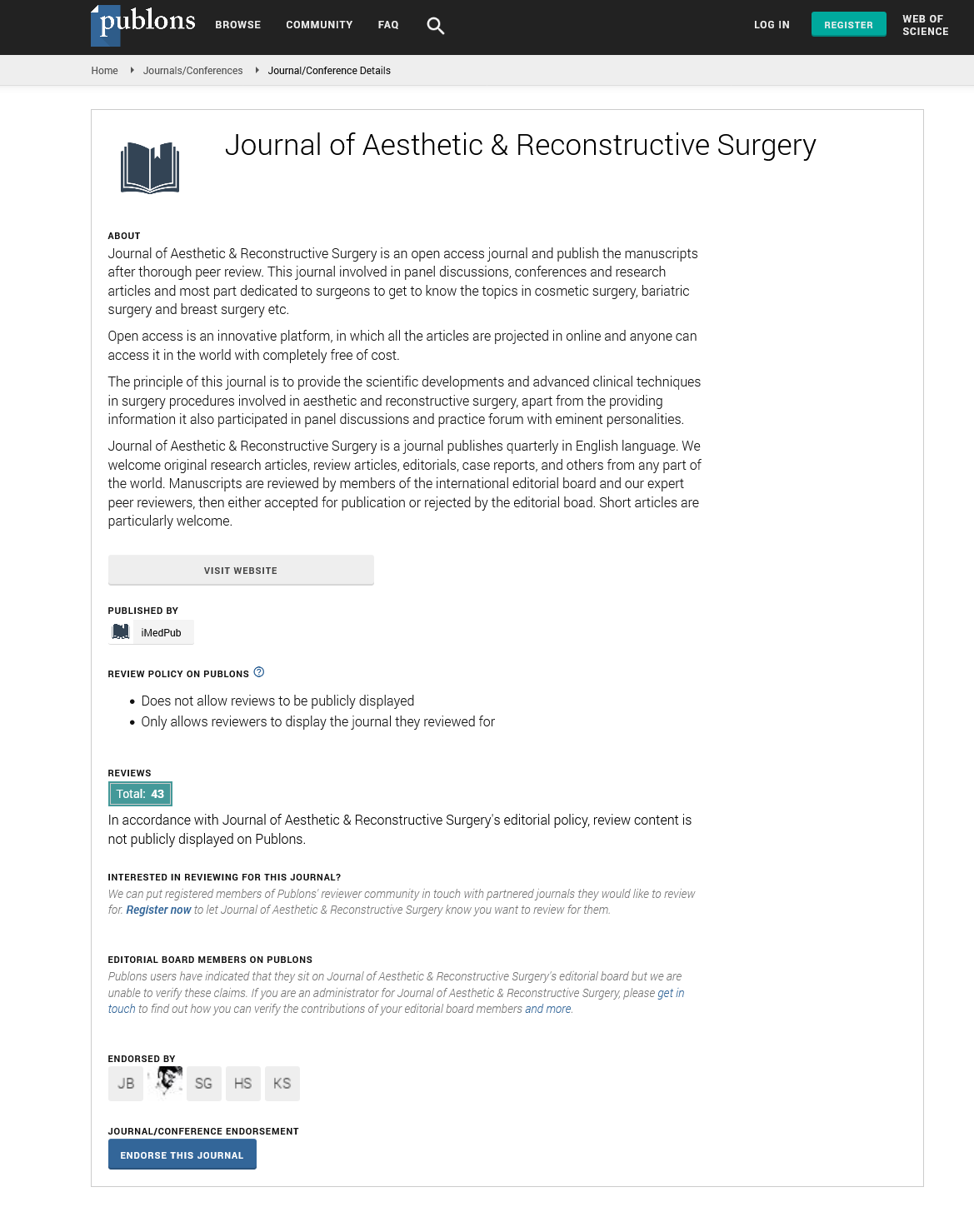ISSN : 2472-1905
Journal of Aesthetic & Reconstructive Surgery
A novel wound dressings with anti-scarring properties
2nd International Conference on Plastic & Aesthetic Surgery
July 27-28, 2017 Vancouver, Canada
Aziz Ghahary
BC Professional Firefighters Burn and Wound Healing Research Group, Canada
Keynote: J Aesthet Reconstr Surg
Abstract
Background: Wound healing outcome is regulated by a fine balance between deposition and degradation of extracellular matrix (ECM). Over healing process in skin is mediated by exaggerated ECM deposition and abnormalities in ECM degradation. Current treatment modalities for prevention of burn hypertrophic scarring has limited efficacy which raised a great need for innovation within wound care industry. Moving towards novel approaches to prevent post burn hypertrophic scarring, we identified the anti-scarring properties of Kynurenine (Kyn), a naturally occurring small molecule generated from tryptophan degradation. Although daily application of Kyn containing cream prevents scarring in a rabbit ear model, an effective wound dressing, slowly releasing controlled doses of Kyn, will be more beneficial for Kyn delivery to extensive burns, where the dressings get changed every 4-5 days.
Aim: This study aims to develop a new generation of wound dressings having anti-scarring properties.
Methods: The Effect of Kyn treatment on the expression of different ECM components, collagen type-I, fibronectin and MMP1 and 3 was evaluated. Wound dressings were manufactured by incorporating Kyn into PVA/PLGA nanofibers using electrospinning process. Drug release profile was determined by incubating the electrospun mats in PBS. The anti-scarring properties of these nanofibrous wound dressings were evaluated in vitro and in vivo.
Results: In vitro studies showed that while Kyn doesn’t have any adverse effect on the dermal cells’ viability, it significantly decreases the expression of collagen type-I and fibronectin and increases the expression of MMP1, which is a collagenase, and MMP3. Whereas, the Kyn-loaded PVA demonstrated immediate and complete drug release of the drug, addition of PLGA envelop via dip-coating significantly reduced the burst release, due to added tortuosity and increased hydrophobicity of the shell. In vivo studies showed that wound treatment with Kyn-loaded dressings significantly improves the wound healing outcome and eliminates evidence of scarring in the rat excisional wounds.
Conclusions: Anti-fibrotic effects of Kyn are mediated by increasing the expression of MMPs and reducing the production of ECM components in vitro and in vivo. This study sets the stage for development of a new generation of wound dressings facilitating the controlled and prolonged release of this anti-scarring drug. Applicability of Research to Practice: These wound dressings can improve/prevent fibrotic conditions developed upon burn, trauma and surgical procedures without compromising the health of the patient.
Biography
Aziz Ghahary, PhD and a Professor, is the Director of the BC Professional Firefighters ‘Burn and Wound Healing Research Group. He has published more than 168 peer-reviewed articles some of which are directly related to autoimmune diseases such as type I diabetes. He has been awarded more than 50 research grants from different local, national and international granting agencies. He is the leading investigator in identifying a serum 14-3-3 eta protein as a biomarker for early detection of RA and psoriatic RA and this test has now been launched by the Quest Diagnosis and Lifelab in US and Canada, respectively. Finally, he recently identified a small molecule with anti-scaring properties, which has now been approved by the Health Canada and the Vancouver General Hospital Ethic Committee to proceed to Phase 1 Clinical Trial.
E-mail: aghahary@mail.ubc.ca
Google Scholar citation report
Citations : 130
Journal of Aesthetic & Reconstructive Surgery received 130 citations as per Google Scholar report
Journal of Aesthetic & Reconstructive Surgery peer review process verified at publons
Abstracted/Indexed in
- Google Scholar
- China National Knowledge Infrastructure (CNKI)
- Directory of Research Journal Indexing (DRJI)
- WorldCat
- Publons
- Geneva Foundation for Medical Education and Research
- Secret Search Engine Labs
- Euro Pub
Open Access Journals
- Aquaculture & Veterinary Science
- Chemistry & Chemical Sciences
- Clinical Sciences
- Engineering
- General Science
- Genetics & Molecular Biology
- Health Care & Nursing
- Immunology & Microbiology
- Materials Science
- Mathematics & Physics
- Medical Sciences
- Neurology & Psychiatry
- Oncology & Cancer Science
- Pharmaceutical Sciences
